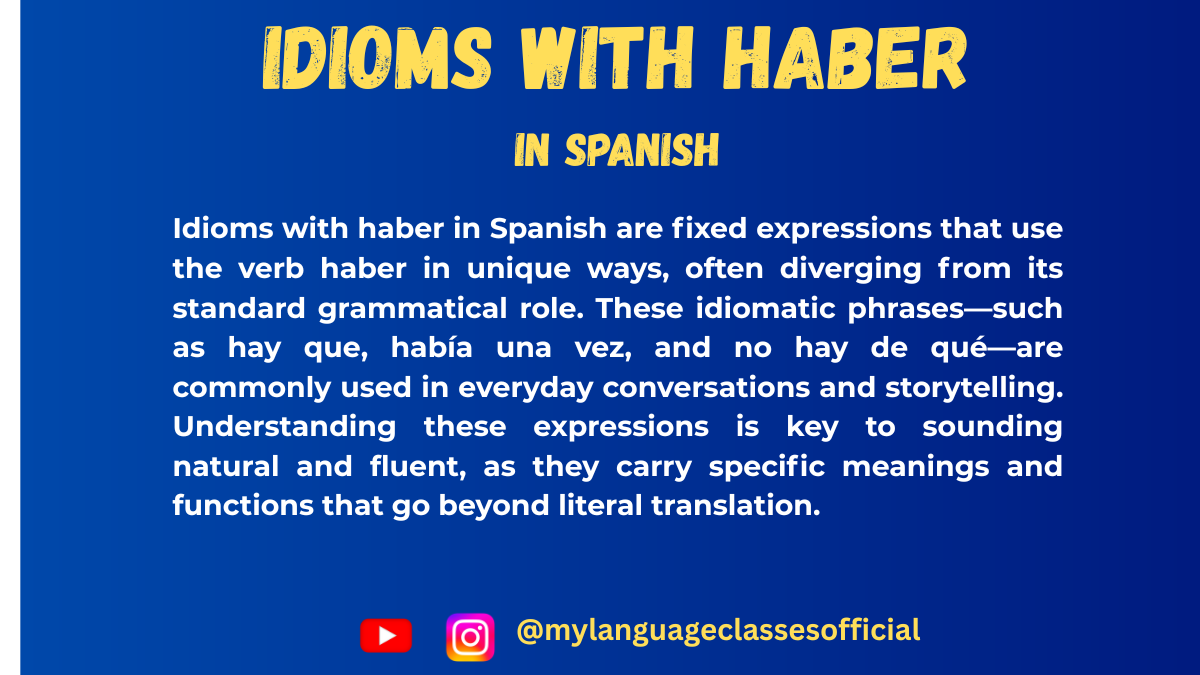Your cart is currently empty!
Tag: writing
-
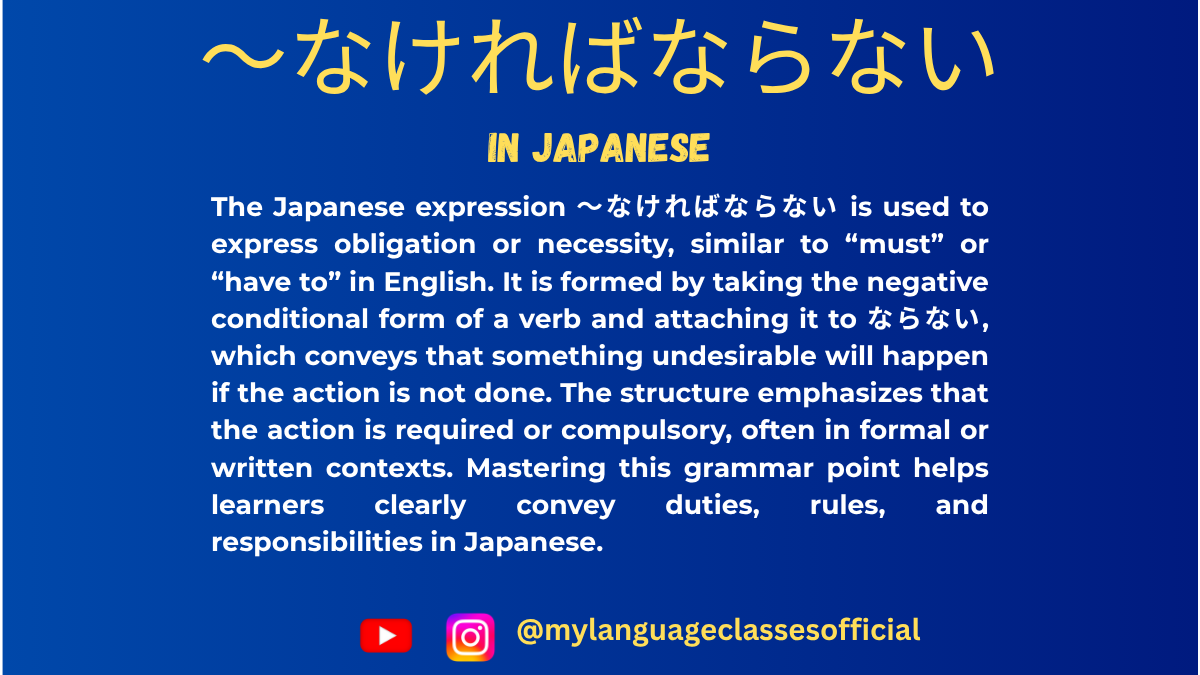
Understanding 〜なければならない in Japanese | My Language Classes
How to Use 〜なければならないin Japanese
The phrase 〜なければならない is a commonly used Japanese grammar structure that expresses obligation or necessity, similar to “must” or “have to” in English. It’s essential for learners to master this phrase because it is frequently used in both formal and casual settings.
Structure of 〜なければならない
- Verb in the Negative Form + なければならない
- Example: 行く → 行かなければならない
(iku → ikanakereba naranai)- Meaning: “I must go.”
- Example: 行く → 行かなければならない
- Conjugation Steps:
- Take the negative form of the verb (ない form).
- Replace ない with なければならない.
Variations of 〜なければならない
- 〜なければいけない
- Another common form with the same meaning.
- Slightly softer in tone.
- 〜なくてはならない
- Less commonly used in casual conversation but often appears in written or formal contexts.
- 〜なくてはいけない
- Similar to 〜なければいけない and used in formal or polite speech.
Situations Where 〜なければならない is Used
Here’s a list of situations where this grammar is appropriate:
1. Rules and Regulations
- Expressing obligations based on rules or laws.
- Example:
- 学校に行かなければならない。
(Gakkou ni ikanakereba naranai.)- Meaning: “I must go to school.”
- 学校に行かなければならない。
2. Work and Responsibilities
- Talking about duties or tasks that must be completed.
- Example:
- 仕事を終わらせなければならない。
(Shigoto o owarasena kereba naranai.)- Meaning: “I must finish the work.”
- 仕事を終わらせなければならない。
3. Social and Cultural Expectations
- Highlighting social norms or obligations.
- Example:
- 礼儀を守らなければならない。
(Reigi o mamorana kereba naranai.)- Meaning: “I must observe proper manners.”
- 礼儀を守らなければならない。
4. Personal Commitments
- Expressing personal resolutions or goals.
- Example:
- ダイエットのために運動しなければならない。
(Daietto no tame ni undou shinakereba naranai.)- Meaning: “I must exercise for my diet.”
- ダイエットのために運動しなければならない。
5. Health and Safety
- Discussing health-related necessities.
- Example:
- 健康のために野菜を食べなければならない。
(Kenkou no tame ni yasai o tabena kereba naranai.)- Meaning: “I must eat vegetables for my health.”
- 健康のために野菜を食べなければならない。
6. Moral or Ethical Obligations
- Talking about what is morally right.
- Example:
- 嘘をついてはいけないし、謝らなければならない。
(Uso o tsuite wa ikenai shi, ayamaranakereba naranai.)- Meaning: “I must not lie, and I must apologize.”
- 嘘をついてはいけないし、謝らなければならない。
7. Deadlines and Time-Sensitive Tasks
- When tasks need to be completed by a specific time.
- Example:
- 今週末までにレポートを提出しなければならない。
(Konshuumatsu made ni repooto o teishutsu shinakereba naranai.)- Meaning: “I must submit the report by this weekend.”
- 今週末までにレポートを提出しなければならない。
Key Points to Remember
- Formality:
- 〜なければならない is slightly more formal than 〜なければいけない. Use it in professional or formal writing.
- Alternative Expressions:
- In casual settings, people often shorten the phrase to 〜なきゃ or 〜なくちゃ.
- Example: 勉強しなきゃいけない (Benkyou shinakya ikenai) = “I must study.”
- In casual settings, people often shorten the phrase to 〜なきゃ or 〜なくちゃ.
- Cultural Context:
- Japanese culture values politeness and rules, so this structure is vital for expressing respect towards societal norms.
- Flexibility:
- While the grammar indicates obligation, tone and context can soften its intensity. For example, “You must” may sound harsh in English, but in Japanese, it’s often a gentle reminder or encouragement.
Practice Exercises
- Convert the following sentences into 〜なければならない form:
- 私は毎日運動する。
- 宿題をする。
- 早く起きる。
- Translate into Japanese:
- I must visit the doctor tomorrow.
- We have to clean the house by this evening.
- Imagine you are living in Japan. Write three sentences about what you “must” do in daily life using 〜なければならない.
Mastering 〜なければならない is crucial for understanding how to express obligations in Japanese effectively. Start using it in your conversations and writing to become more natural and fluent!
If you enjoyed this lesson, be sure to check out more posts like this on my blog at My Language Classes. Don’t forget to subscribe my YouTube channel and follow me on Instagram for the latest language learning tips and lessons. Leave a comment below to share your thoughts, or ask any questions you have about nouns.
Happy learning! 😊
- Verb in the Negative Form + なければならない
-
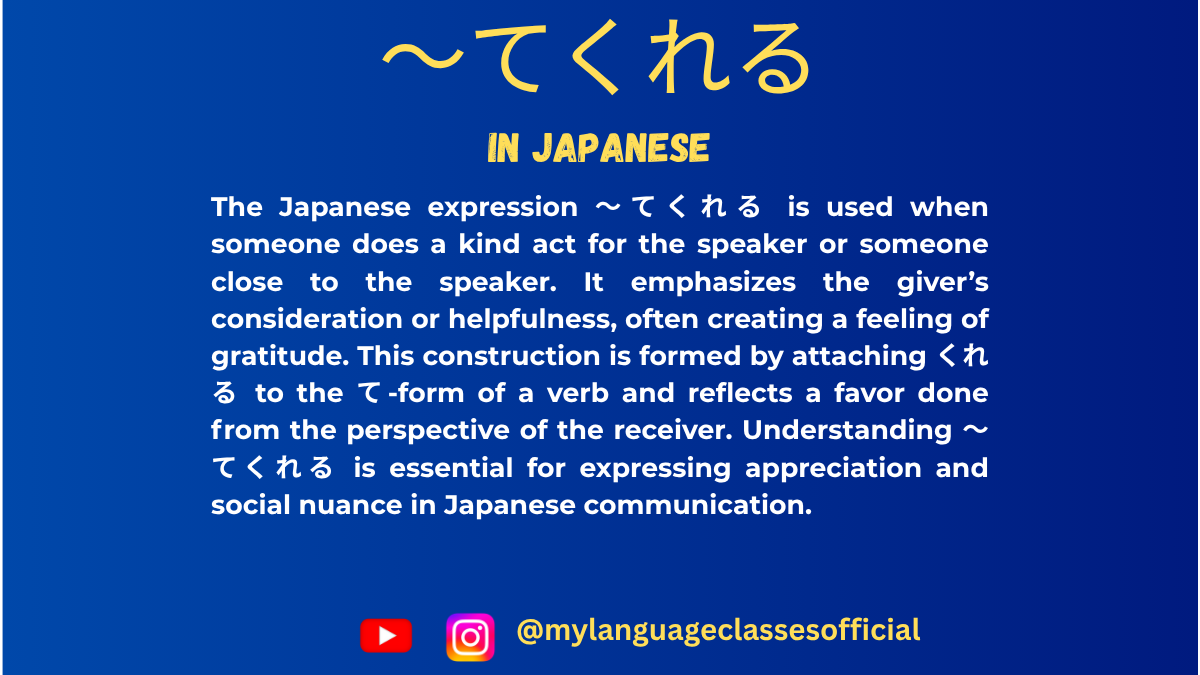
How to Use 〜てくれる | My Language Classes
Understanding “〜てくれる” in Japanese
The Japanese expression 〜てくれる is a key grammatical structure used to describe actions done for the speaker’s benefit or someone close to them. It conveys gratitude and appreciation towards the doer. Let’s explore its usage in various contexts and provide a list of situations where “〜てくれる” is used.
What is 〜てくれる?
“〜てくれる” is derived from the verb くれる, which means “to give.” When attached to the て-form of a verb, it expresses that someone performs an action for the speaker (or someone in the speaker’s inner circle). It implies a sense of appreciation and goodwill.
- Structure:
[Person] が [Verb (て-form)] くれる
(Someone does something for me or someone in my group.) - Example:
- 友達が宿題を手伝ってくれた。
(Tomodachi ga shukudai o tetsudatte kureta.)
→ “My friend helped me with my homework.” - 先生が日本語を教えてくれました。
(Sensei ga Nihongo o oshiete kuremashita.)
→ “The teacher kindly taught me Japanese.”
- 友達が宿題を手伝ってくれた。
Situations Where 〜てくれる is Used
1. When Someone Helps You
Used when someone provides assistance that benefits the speaker.
- Example:
- 兄が荷物を運んでくれた。 (Ani ga nimotsu o hakonde kureta.)
→ “My older brother carried my luggage for me.”
- 兄が荷物を運んでくれた。 (Ani ga nimotsu o hakonde kureta.)
2. When Someone Gives You Something
Used when someone gives you an object (related to くれる itself).
- Example:
- 友達がプレゼントを買ってくれた。 (Tomodachi ga purezento o katte kureta.)
→ “My friend bought me a present.”
- 友達がプレゼントを買ってくれた。 (Tomodachi ga purezento o katte kureta.)
3. When Someone Does a Favor for You
Used when someone voluntarily does something kind.
- Example:
- 彼が傘を貸してくれた。 (Kare ga kasa o kashite kureta.)
→ “He lent me an umbrella.”
- 彼が傘を貸してくれた。 (Kare ga kasa o kashite kureta.)
4. When Someone Teaches or Instructs You
Used when someone imparts knowledge or skills.
- Example:
- 先生が漢字の書き方を教えてくれた。 (Sensei ga kanji no kakikata o oshiete kureta.)
→ “The teacher taught me how to write kanji.”
- 先生が漢字の書き方を教えてくれた。 (Sensei ga kanji no kakikata o oshiete kureta.)
5. When Someone Listens to You
Used when someone listens or gives attention to you.
- Example:
- 友達が悩みを聞いてくれた。 (Tomodachi ga nayami o kiite kureta.)
→ “My friend listened to my worries.”
- 友達が悩みを聞いてくれた。 (Tomodachi ga nayami o kiite kureta.)
6. When Someone Accompanies You
Used when someone goes with you somewhere.
- Example:
- 母が病院まで一緒に行ってくれた。 (Haha ga byouin made issho ni itte kureta.)
→ “My mother went to the hospital with me.”
- 母が病院まで一緒に行ってくれた。 (Haha ga byouin made issho ni itte kureta.)
7. When Someone Encourages or Supports You
Used when someone gives encouragement.
- Example:
- 彼が試験の前に励ましてくれた。 (Kare ga shiken no mae ni hagemashite kureta.)
→ “He encouraged me before the exam.”
- 彼が試験の前に励ましてくれた。 (Kare ga shiken no mae ni hagemashite kureta.)
8. When Someone Waits for You
Used when someone waits patiently for you.
- Example:
- 友達が駅で待ってくれた。 (Tomodachi ga eki de matte kureta.)
→ “My friend waited for me at the station.”
- 友達が駅で待ってくれた。 (Tomodachi ga eki de matte kureta.)
9. When Someone Fixes or Repairs Something for You
Used when someone fixes something for your benefit.
- Example:
- 父が自転車を直してくれた。 (Chichi ga jitensha o naoshite kureta.)
→ “My father fixed my bicycle.”
- 父が自転車を直してくれた。 (Chichi ga jitensha o naoshite kureta.)
10. When Someone Invites You or Gives You a Treat
Used when someone invites or pays for you.
- Example:
- 彼がコーヒーをおごってくれた。 (Kare ga koohii o ogotte kureta.)
→ “He treated me to coffee.”
- 彼がコーヒーをおごってくれた。 (Kare ga koohii o ogotte kureta.)
Notes on Usage
- Subject Consideration:
- The giver of the action is the grammatical subject, not the receiver.
- Example:
- 彼がケーキを作ってくれた。 (He made a cake for me.)
- 私にケーキを作ってくれた is unnatural (omit 私に).
- Politeness Levels:
- Casual: 〜てくれる
- Polite: 〜てくれます
- Past polite: 〜てくれました
- Not Used for Superior-to-Subordinate Actions:
- You cannot use 〜てくれる when a subordinate (like a junior worker) does something for a superior (like a boss). Instead, use 〜てくださいました (keigo).
Conclusion
The expression 〜てくれる is an essential part of Japanese communication, showing gratitude when someone does something beneficial for the speaker. By understanding the different contexts in which it is used, learners can express appreciation naturally and appropriately in Japanese conversations.
Do you have any questions about 〜てくれる? Let me know in the comments! 😊
If you enjoyed this lesson, be sure to check out more posts like this on my blog at My Language Classes. Don’t forget to subscribe my YouTube channel and follow me on Instagram for the latest language learning tips and lessons. Leave a comment below to share your thoughts, or ask any questions you have about nouns.
Happy learning! 😊
- Structure:
-
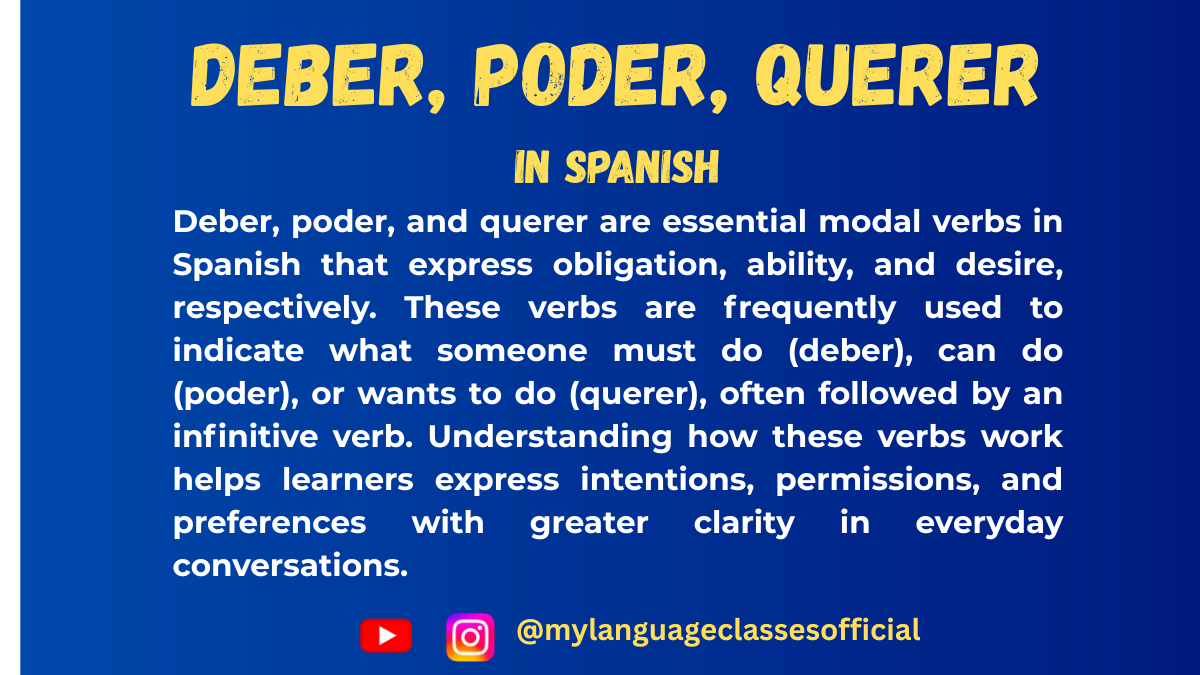
Deber, Poder, Querer: Expressing Obligation, Possibility, and Desire in Spanish
In Spanish, the verbs deber, poder, and querer are commonly used to express obligation, possibility, and desire, respectively. Understanding how to use these verbs correctly is essential for fluent communication. In this blog post, we will explore their meanings, conjugations, and common expressions used in daily life.
1. Deber – Expressing Obligation
The verb deber translates to “must” or “should” in English and is used to indicate duty, necessity, or moral obligation.
Common Expressions with Deber
- Deber + infinitivo → “Must/should do something.”
- Debo estudiar para el examen. (I must study for the exam.)
- Debes comer más verduras. (You should eat more vegetables.)
- Deber de + infinitivo → Expresses probability or supposition.
- Debe de estar en casa. (He/She must be at home.)
Conjugation of Deber
Tense Conjugation Present Indicative debo, debes, debe, debemos, debéis, deben Preterite debí, debiste, debió, debimos, debisteis, debieron Imperfect debía, debías, debía, debíamos, debíais, debían Present Subjunctive deba, debas, deba, debamos, debáis, deban Imperative (no direct affirmative imperative; use subjunctive)
2. Poder – Expressing Possibility and Ability
The verb poder means “can” or “to be able to.” It is used to express ability, permission, or possibility.
Common Expressions with Poder
- Poder + infinitivo → “To be able to do something.”
- Puedo nadar bien. (I can swim well.)
- No puedes entrar sin permiso. (You can’t enter without permission.)
- ¿Se puede…? → Asking for permission.
- ¿Se puede fumar aquí? (Can one smoke here?)
- No poder más → “To be unable to handle something anymore.”
- No puedo más con este calor. (I can’t take this heat anymore.)
Conjugation of Poder (Irregular Verb)
Tense Conjugation Present Indicative puedo, puedes, puede, podemos, podéis, pueden Preterite pude, pudiste, pudo, pudimos, pudisteis, pudieron Imperfect podía, podías, podía, podíamos, podíais, podían Present Subjunctive pueda, puedas, pueda, podamos, podáis, puedan Imperative (no direct affirmative imperative; use subjunctive)
3. Querer – Expressing Desire and Intentions
The verb querer means “to want” or “to love.” It is used to express desires, wishes, and sometimes affection.
Common Expressions with Querer
- Querer + infinitivo → “To want to do something.”
- Quiero viajar a España. (I want to travel to Spain.)
- ¿Quieres salir esta noche? (Do you want to go out tonight?)
- Querer a alguien → “To love someone.”
- Te quiero mucho. (I love you a lot.)
- Querer decir → “To mean.”
- ¿Qué quiere decir esta palabra? (What does this word mean?)
Conjugation of Querer (Irregular Verb)
Tense Conjugation Present Indicative quiero, quieres, quiere, queremos, queréis, quieren Preterite quise, quisiste, quiso, quisimos, quisisteis, quisieron Imperfect quería, querías, quería, queríamos, queríais, querían Present Subjunctive quiera, quieras, quiera, queramos, queráis, quieran Imperative (no direct affirmative imperative; use subjunctive)
Key Considerations When Using Deber, Poder, Querer
- Articles and Gender:
- Use el, la, los, las with nouns when necessary.
- Example: Debes respetar las reglas. (You must respect the rules.)
- Plural vs. Singular:
- Conjugate the verb based on the subject.
- Example: Ellos pueden hablar inglés. (They can speak English.)
- Using the Subjunctive:
- Often follows expressions of doubt, wishes, or hypothetical scenarios.
- Example: Quiero que vengas conmigo. (I want you to come with me.)
- Negation:
- Use “no” before the verb to make it negative.
- Example: No debes mentir. (You must not lie.)
Conclusion
Mastering deber, poder, and querer is essential for effective communication in Spanish. These verbs allow you to express obligation, possibility, and desire in various situations. By understanding their conjugations, common expressions, and proper grammatical usage, you will significantly enhance your Spanish fluency. Keep practicing, and soon, you’ll be able to use them naturally in conversations!
If you enjoyed this lesson, be sure to check out more posts like this on my blog at My Language Classes. Don’t forget to subscribe my YouTube channel and follow me on Instagram for the latest language learning tips and lessons. Leave a comment below to share your thoughts, or ask any questions you have.
Happy learning! 😊
- Deber + infinitivo → “Must/should do something.”
-

How to Use 〜てもらう | My Language Classes
The Japanese Grammar 〜てもらう
The Japanese grammar pattern 〜てもらう is an essential structure used to express receiving a favor from someone. It emphasizes that someone is doing something beneficial for the speaker or a third party. Understanding this grammar is crucial for natural and polite Japanese communication.
This post will explain 〜てもらう in various situations, provide example sentences, and list common contexts where it is used.
Structure of 〜てもらう
The pattern follows this structure:
Person A (receiver) + は/が + Person B (doer) + に + Verb in 〜て form + もらう
- A is the person who benefits from the action.
- B is the person performing the action for A.
- The verb is conjugated into the て-form and followed by もらう (to receive).
Example:
- 私は先生に日本語を教えてもらいました。
(I had my teacher teach me Japanese.)
Difference Between 〜てもらう and 〜てあげる
- 〜てもらう: Focuses on the receiver of the favor.
- 〜てあげる: Focuses on the giver of the favor.
Example:
- 私は先生に日本語を教えてもらいました。 (I received Japanese lessons from my teacher.)
- 私は先生に日本語を教えてあげました。 (I taught Japanese to my teacher.)
Various Situations Where 〜てもらう Is Used
1. Receiving Help
When someone helps you with a task or does something for your benefit.
Example:
- 私は彼氏に財実を送ってもらいました。
(I had my boyfriend send my wallet.)
2. Receiving Permission
Used when asking for permission to do something.
Example:
- 先生にはやく帰らせてもらいました。
(I got permission from my teacher to leave early.)
3. Receiving a Favor Indirectly
You receive a favor, but a third party performs the action.
Example:
- 母は先生にむすこの学校の事を説明してもらいました。
(My mother had the teacher explain about the school to her.)
4. Making Polite Requests
When requesting someone to do something politely.
Example:
- この文章を正しく直してもらえますか。
(Could you please correct this text for me?)
5. Receiving Information
When someone shares knowledge or guidance.
Example:
- 先生にいろいろな情報を教えてもらいました。
(I received a lot of information from my teacher.)
6. Asking for Medical Assistance
Used when getting treatment or medical help from someone.
Example:
- 医者に病治をしてもらいました。
(I got treated by the doctor.)
7. Receiving a Physical Object
Used when someone gives you something.
Example:
- 友人に好きな本を買ってもらいました。
(My friend bought me a book I like.)
8. Receiving Guidance or Instructions
Used when someone teaches you or gives instructions.
Example:
- 先生に作文の書き方を教えてもらいました。
(I had my teacher teach me how to write essays.)
Summary of Situations Where 〜てもらう Is Used
Here’s a quick reference list:
- Receiving help (task-related support)
- Receiving permission
- Receiving a favor indirectly
- Making polite requests
- Receiving information or knowledge
- Asking for medical assistance
- Receiving a physical object
- Receiving guidance or instructions
Conclusion
〜てもらう is a crucial grammar point in Japanese, allowing you to express receiving favors, help, or benefits from others. Mastering this structure enhances your ability to communicate politely and effectively in various situations. Practice using it in conversations to improve fluency and comprehension!
If you enjoyed this lesson, be sure to check out more posts like this on my blog at My Language Classes. Don’t forget to subscribe my YouTube channel and follow me on Instagram for the latest language learning tips and lessons. Leave a comment below to share your thoughts, or ask any questions you have about nouns.
Happy learning! 😊
-
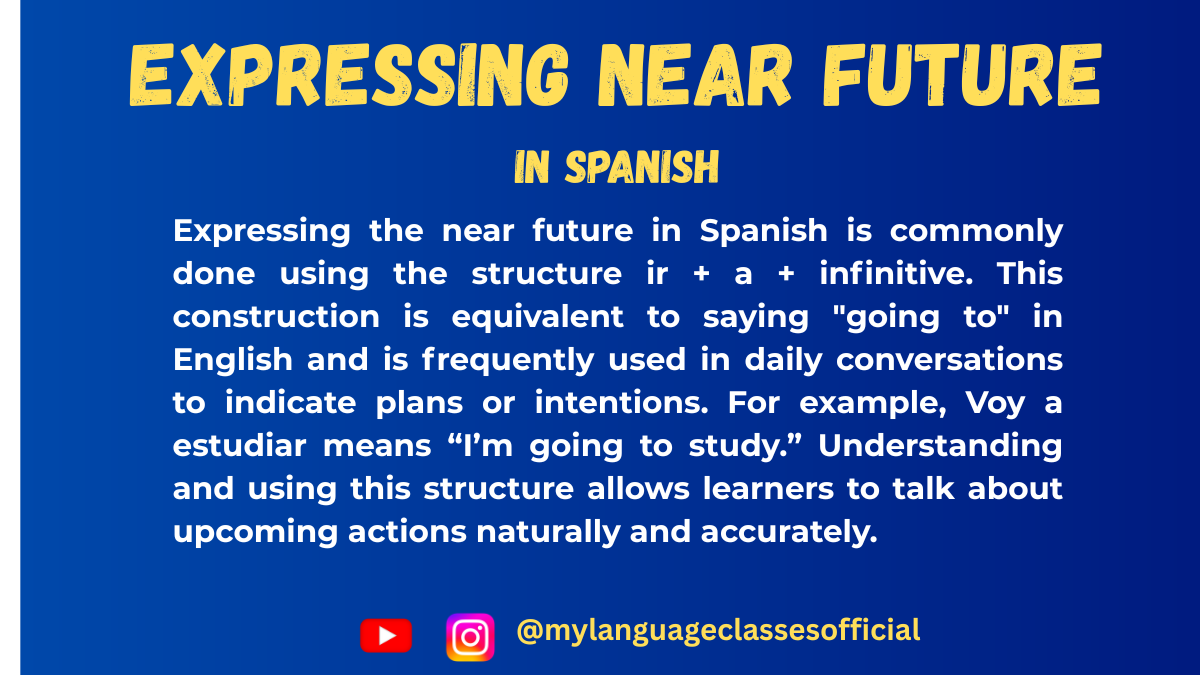
Ir a + Infinitive: Expressing Near Future in Spanish
In Spanish, the construction “Ir a + infinitive” is commonly used to express actions that will happen in the near future. This is equivalent to the English “going to + verb” structure. It is widely used in spoken and written Spanish and is easier to learn compared to the simple future tense.
Formation of “Ir a + Infinitive”
The structure consists of three elements:
- The verb “ir” (to go) conjugated in the present tense.
- The preposition “a” (to).
- An infinitive verb (unconjugated verb).
Conjugation of “Ir” in Present Tense:
Subject Pronoun Conjugation of “Ir” Yo voy Tú vas Él/Ella/Usted va Nosotros/as vamos Vosotros/as vais Ellos/Ellas/Ustedes van Sentence Structure:
Subject + Ir (conjugated) + a + Infinitive Verb
Example Sentences:
- Voy a estudiar. (I am going to study.)
- Vamos a viajar a México. (We are going to travel to Mexico.)
- Ellos van a comprar una casa. (They are going to buy a house.)
Usage of “Ir a + Infinitive”
1. Near Future Actions
Used to express something that is about to happen soon.
- Voy a llamar a mi madre. (I am going to call my mother.)
- Ella va a cocinar la cena. (She is going to cook dinner.)
2. Intentions or Plans
Used when someone has planned to do something.
- Vamos a ver una película esta noche. (We are going to watch a movie tonight.)
- Voy a aprender español este año. (I am going to learn Spanish this year.)
3. Predictions Based on Evidence
Used when there is evidence that something is about to happen.
- Va a llover. (It is going to rain.)
- El bebé va a llorar. (The baby is going to cry.)
4. Giving Commands or Warnings
Used to give warnings or strong suggestions.
- Vas a romper el vaso. (You are going to break the glass.)
- Van a llegar tarde si no se apuran. (You all are going to be late if you don’t hurry.)
Articles, Gender, and Plural Considerations
When using “Ir a + Infinitive,” remember:
- Definite Articles (el, la, los, las) and Indefinite Articles (un, una, unos, unas) should match the noun in gender and number.
- Example: Voy a comprar una bicicleta. (I am going to buy a bicycle.)
- Example: Vamos a visitar el museo. (We are going to visit the museum.)
- Verb agreement: The conjugation of “ir” changes based on the subject.
- The infinitive verb does not change regardless of the subject.
Common Verbs Used with “Ir a + Infinitive”
Here is a list of common verbs and their “Ir a + Infinitive” forms:
Infinitive Verb Meaning “Ir a + Infinitive” Example Comer To eat Voy a comer pizza. (I am going to eat pizza.) Beber To drink Vas a beber agua. (You are going to drink water.) Estudiar To study Ella va a estudiar matemáticas. (She is going to study mathematics.) Viajar To travel Vamos a viajar a España. (We are going to travel to Spain.) Comprar To buy Van a comprar un coche. (They are going to buy a car.) Hacer To do/make Voy a hacer mi tarea. (I am going to do my homework.) Tener To have Vas a tener una sorpresa. (You are going to have a surprise.) Llegar To arrive Ella va a llegar temprano. (She is going to arrive early.) Jugar To play Vamos a jugar fútbol. (We are going to play soccer.) Dormir To sleep Van a dormir temprano. (They are going to sleep early.) Regular and Irregular Verbs in “Ir a + Infinitive”
All verbs, whether regular or irregular, remain in the infinitive form after “a.”
Regular Verbs (AR, ER, IR Verbs)
- Hablar (to speak): Voy a hablar con mi amigo. (I am going to speak with my friend.)
- Comer (to eat): Vamos a comer paella. (We are going to eat paella.)
- Vivir (to live): Ellos van a vivir en Barcelona. (They are going to live in Barcelona.)
Irregular Verbs
- Hacer (to do/make): Voy a hacer la tarea. (I am going to do the homework.)
- Tener (to have): Ella va a tener una fiesta. (She is going to have a party.)
- Poder (to be able to): Van a poder salir temprano. (They are going to be able to leave early.)
Conclusion
The “Ir a + Infinitive” structure is one of the most practical and commonly used ways to express the near future in Spanish. It is simple to form and widely understood in all Spanish-speaking regions. By practicing this structure with different verbs, you can quickly improve your Spanish fluency and express future plans with confidence.
Now that you understand how to use “Ir a + Infinitive”, start practicing by forming your own sentences!
If you enjoyed this lesson, be sure to check out more posts like this on my blog at My Language Classes. Don’t forget to subscribe my YouTube channel and follow me on Instagram for the latest language learning tips and lessons. Leave a comment below to share your thoughts, or ask any questions you have.
Happy learning! 😊
-
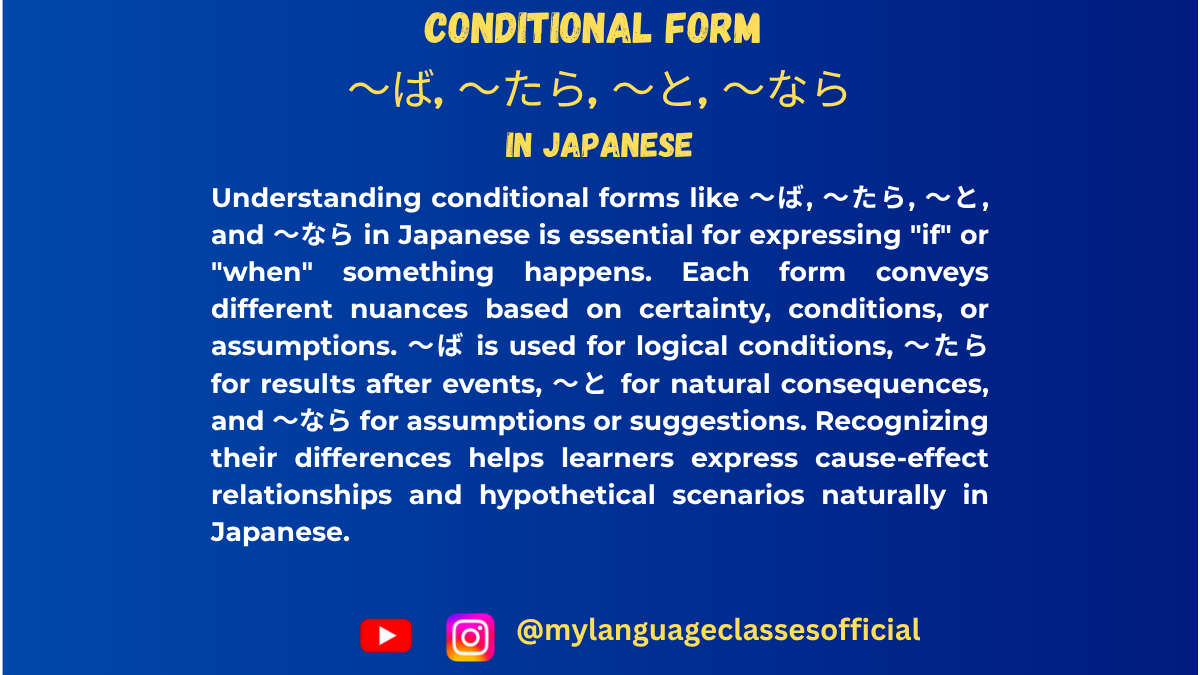
All Japanese Conditionals 〜ば, 〜たら, 〜と, 〜ならExplained | My Language Classes
Japanese Conditional Forms: 〜ば, 〜たら, 〜と, 〜なら Explained
In Japanese, conditional and hypothetical sentences are commonly expressed using four key grammatical structures: 〜ば, 〜たら, 〜と, and 〜なら. Each has unique nuances and appropriate usage contexts. In this article, we will explore each form, compare them, and provide a list of situations where they are used.
1. 〜ば (Ba-form)
Usage:
- Expresses general conditions and hypothetical situations.
- Often used in formal speech and writing.
- Cannot be used for past events.
- Cannot be used with volitional expressions (e.g., requests, invitations).
Formation:
Verb Type Formation Ichidan (る-verbs) Drop る + れば (e.g., 食べる → 食べれば) Godan (う-verbs) Change last う-row syllable to え-row + ば (e.g., 行く → 行けば) Adjectives (い-adj.) Drop い + ければ (e.g., 安い → 安ければ) Nouns/な-adjectives + ならば (e.g., 便利ならば) Examples:
- 早く行けば、電車に間に合いますよ。(If you go early, you will catch the train.)
- お金があれば、旅行したいです。(If I have money, I want to travel.)
- 静かであれば、勉強しやすいです。(If it is quiet, it is easy to study.)
2. 〜たら (Tara-form)
Usage:
- Used for general conditions, past conditions, and hypothetical situations.
- Can be used in past, present, or future contexts.
- Can be used with volitional expressions (e.g., requests, invitations).
Formation:
Word Type Formation Verbs (Past た-form + ら) 飲む → 飲んだら い-adjectives 楽しい → 楽しかったら な-adjectives / Nouns 簡単だ → 簡単だったら Examples:
- 雨が降ったら、家にいます。(If it rains, I will stay home.)
- お金があったら、旅行に行きたいです。(If I had money, I would travel.)
- 暇だったら、手伝ってください。(If you are free, please help.)
3. 〜と (To-form)
Usage:
- Expresses natural consequences, habitual results, and general truths.
- Does not express personal volition or future uncertainty.
- Common in proverbs and scientific facts.
Formation:
Word Type Formation Verbs (Dictionary form + と) 行く → 行くと い-adjectives 高い → 高いと な-adjectives / Nouns 便利だ → 便利だと Examples:
- 春になると、桜が咲きます。(When spring comes, cherry blossoms bloom.)
- このボタンを押すと、ドアが開きます。(If you press this button, the door will open.)
- 夜になると、気温が下がります。(When it becomes night, the temperature drops.)
4. 〜なら (Nara-form)
Usage:
- Used for assumptions, recommendations, and contextual conditions.
- Often used in conversations.
- Used when giving advice or referring to prior information.
Formation:
Word Type Formation Verbs (Dictionary form + なら) 行く → 行くなら い-adjectives 面白い → 面白いなら な-adjectives / Nouns 簡単だ → 簡単なら Examples:
- 日本に行くなら、京都を訪れるべきです。(If you go to Japan, you should visit Kyoto.)
- お金がないなら、アルバイトをしたほうがいい。(If you don’t have money, you should get a part-time job.)
- 映画を見るなら、ポップコーンを買いましょう。(If we’re watching a movie, let’s buy popcorn.)
5. Comparison Table: 〜ば vs. 〜たら vs. 〜と vs. 〜なら
Condition Type 〜ば 〜たら 〜と 〜なら General Conditions ✅ ✅ ✅ ✅ Hypothetical Situations ✅ ✅ ❌ ✅ Past Situations ❌ ✅ ❌ ✅ Natural Consequences ❌ ❌ ✅ ❌ Volitional Expressions ❌ ✅ ❌ ✅ Recommendations/Advice ❌ ❌ ❌ ✅
6. Situations Where They Are Used
Situation Example Best Form If it rains, I will stay home. 雨が降ったら、家にいます。 〜たら If you push this button, the door will open. このボタンを押すと、ドアが開きます。 〜と If I had money, I would travel. お金があれば、旅行したい。 〜ば If you are free, please help me. 暇だったら、手伝ってください。 〜たら If you go to Japan, you should visit Kyoto. 日本に行くなら、京都を訪れるべきです。 〜なら If you don’t study, you will fail the exam. 勉強しないと、試験に落ちる。 〜と
Conclusion
Each of these conditional forms—〜ば, 〜たら, 〜と, and 〜なら—has its specific nuances and contexts. By mastering these distinctions, learners can express conditional and hypothetical ideas naturally and accurately in Japanese. Understanding when to use each structure will significantly improve fluency and comprehension.
If you enjoyed this lesson, be sure to check out more posts like this on my blog at My Language Classes. Don’t forget to subscribe my YouTube channel and follow me on Instagram for the latest language learning tips and lessons. Leave a comment below to share your thoughts, or ask any questions you have about nouns.
Happy learning! 😊
-

Basic Sentence Structure in English: Subject-Verb-Object
Mastering basic sentence structure is a fundamental step in learning English. At its core, English follows a simple and logical pattern: Subject-Verb-Object (SVO). Understanding this structure is essential for forming clear and grammatically correct sentences. Let’s dive into the details.
1. What is the Subject-Verb-Object Structure?
- Subject (S): The subject is the “doer” of the action. It answers the question, Who or what is performing the action?
- Verb (V): The verb represents the action or state. It tells us what the subject is doing or what is happening.
- Object (O): The object is the recipient of the action. It answers the question, Who or what is affected by the action?
Example Sentence:
- Subject: The cat
- Verb: chased
- Object: the mouse
Complete Sentence: The cat chased the mouse.
2. Articles in Sentence Structure
Articles are small words that define nouns. In English, we use:
- Definite article (the): Refers to specific nouns.
- Indefinite articles (a, an): Refer to non-specific nouns.
Example:
- The boy kicked a ball.
Here, “the boy” refers to a specific boy, while “a ball” refers to any ball.
3. Nouns and Their Role
Nouns are the backbone of any sentence. They can function as subjects or objects.
- Types of Nouns: Common (dog, city), Proper (John, London), Abstract (love, happiness), and Concrete (book, table).
- Example:
- Common noun: A teacher explained the lesson.
- Proper noun: Maria read the book.
4. Pronouns in Sentence Structure
Pronouns replace nouns to avoid repetition. Common pronouns include:
- Subject pronouns: I, you, he, she, it, we, they
- Object pronouns: me, you, him, her, it, us, them
Example:
- Instead of: John loves Maria. Maria loves John.
- Use pronouns: He loves her. She loves him.
5. Verbs and Tenses
Verbs are the action or state of being in a sentence. They change form to indicate time (past, present, future).
- Example in SVO format:
- Present: She eats an apple.
- Past: She ate an apple.
- Future: She will eat an apple.
6. Gender in Sentence Structure
In English, gender impacts the choice of pronouns but not verb forms. Nouns may also suggest gender, though this is not as common as in some other languages.
- Examples:
- Masculine: He is a doctor.
- Feminine: She is a doctor.
- Neutral: They are a teacher.
7. Adjectives and Sentence Expansion
Adjectives describe nouns and can be added to the SVO structure for more detail.
Example:
- Basic: The girl read a book.
- Expanded: The young girl read an interesting book.
8. Prepositions and Sentence Variation
Prepositions show relationships between words, such as location, direction, or time.
Example:
- Basic: She placed the book.
- With preposition: She placed the book on the table.
9. Word Order Rules
English relies heavily on word order for clarity. Unlike some languages that use inflections, English maintains:
- Subject first: The dog barked.
- Verb second: The dog barked.
- Object last: The dog barked at the stranger.
10. Practice and Tips
- Start simple: Form basic SVO sentences like “I eat apples.”
- Expand gradually: Add adjectives, prepositions, or conjunctions to build complex sentences.
- Check word order: Ensure your subject comes before the verb and the object follows it.
Conclusion
The Subject-Verb-Object structure is the cornerstone of English sentence formation. By understanding the roles of articles, nouns, pronouns, and other components, you can construct sentences with confidence. Practice regularly, and soon, building sentences will feel natural!
Happy learning! 😊
📚 Easy grammar tips for beginners!
📲 Follow on Instagram and explore more on YouTubeRead more blogs at mylanguageclassesblog.wordpress.com
-
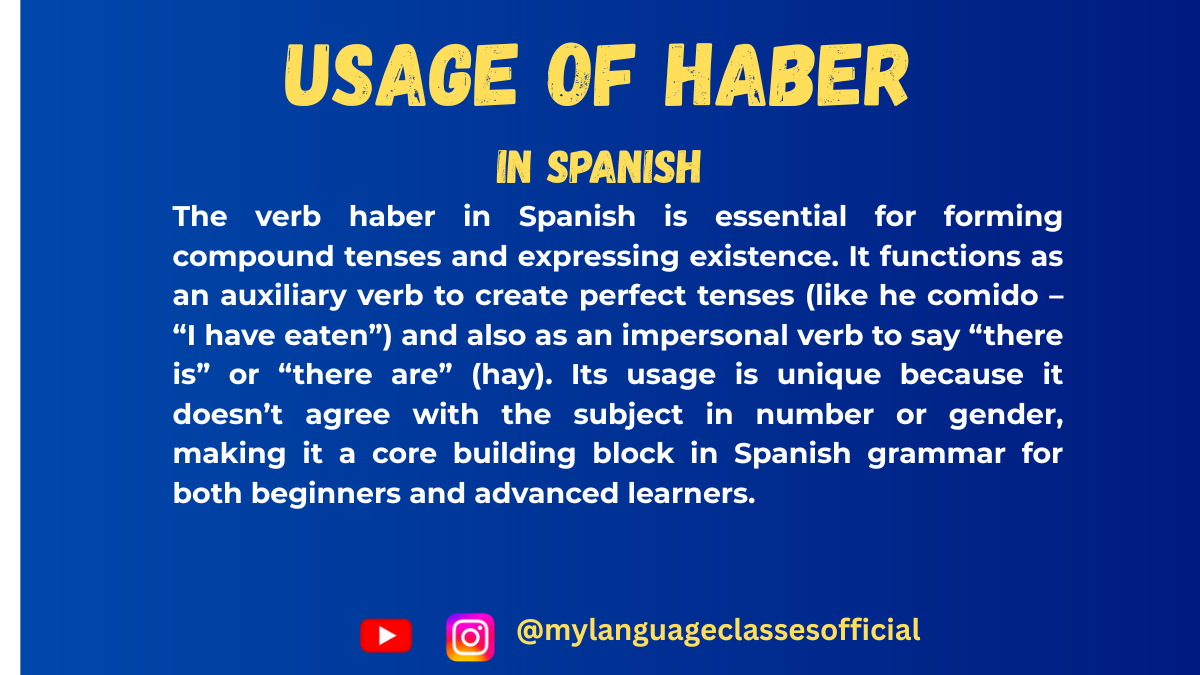
Mastering “Haber” in Spanish
The Spanish verb haber is one of the most versatile and fundamental verbs in the language. Understanding its uses, forms, and common expressions is essential for communicating effectively in Spanish. In this blog post, we will explore the different contexts in which “haber” is used, along with a list of commonly used expressions and examples.
1. What Is “Haber”?
“Haber” is an irregular verb in Spanish that serves multiple grammatical purposes. It does not directly translate into English but has different meanings and uses depending on the context. It can function as:
- An auxiliary verb: To form compound tenses.
- An impersonal verb: To express existence.
- Part of idiomatic expressions: Used in fixed phrases common in daily speech.
2. Forms of “Haber”
The conjugation of “haber” varies greatly depending on the tense and mood. Here are some key forms:
Present tense (indicative):
- He, has, ha, hemos, habéis, han
Past tense (preterite):
- Hube, hubiste, hubo, hubimos, hubisteis, hubieron
Imperfect tense:
- Había, habías, había, habíamos, habíais, habían
Subjunctive mood (present):
- Haya, hayas, haya, hayamos, hayáis, hayan
Impersonal form (used in expressions):
- Hay (present), hubo (preterite), había (imperfect)
3. Key Uses of “Haber”
A. As an Auxiliary Verb
“Haber” is used to form compound tenses, similar to “have” in English. It combines with the past participle of the main verb.
- Present Perfect (Pretérito Perfecto): Used to talk about actions that happened in the past but are relevant to the present.
- Example: He comido. (I have eaten.)
- Past Perfect (Pluscuamperfecto): Describes actions that occurred before another past action.
- Example: Había estudiado antes del examen. (I had studied before the exam.)
- Future Perfect (Futuro Perfecto): Refers to actions that will have been completed by a certain point in the future.
- Example: Habré terminado para las cinco. (I will have finished by five.)
B. As an Impersonal Verb
“Haber” is used in its impersonal form to express existence. The subject is not a person, and it is typically followed by a noun.
- Present Tense:Hay (There is/There are)
- Example: Hay un libro en la mesa. (There is a book on the table.)
- Example: Hay muchas flores en el jardín. (There are many flowers in the garden.)
- Past Tense:
- Hubo (preterite): Refers to events or existence at a specific moment in the past.
- Example: Hubo un accidente en la carretera. (There was an accident on the road.)
- Había (imperfect): Describes an ongoing or habitual past situation.
- Example: Había mucha gente en la fiesta. (There were many people at the party.)
- Hubo (preterite): Refers to events or existence at a specific moment in the past.
- Future Tense:Habrá (There will be)
- Example: Habrá una reunión mañana. (There will be a meeting tomorrow.)
C. Common Expressions with “Haber”
Here are some of the most common idiomatic expressions with “haber,” their meanings, and example sentences:
- Hay que + infinitive
Meaning: One must/It is necessary to.- Example: Hay que estudiar para aprobar el examen. (One must study to pass the exam.)
- Haber de + infinitive
Meaning: To have to (mild obligation or future intention).- Example: He de hablar con ella. (I must talk to her.)
- Haber lugar
Meaning: To have room or to be possible.- Example: No hay lugar para más invitados. (There is no room for more guests.)
- No hay de qué
Meaning: You’re welcome (literally, there is no reason to thank).- Example: Gracias por tu ayuda. No hay de qué. (Thanks for your help. You’re welcome.)
- Haber que ver con
Meaning: To have to do with something.- Example: Eso no tiene nada que ver conmigo. (That has nothing to do with me.)
- Habérselas con alguien
Meaning: To deal with someone (often confrontational).- Example: Hoy me las he tenido que ver con mi jefe. (Today, I had to deal with my boss.)
4. Things to Keep in Mind
When using “haber,” remember the following:
Articles and Gender:
- “Haber” in its impersonal form (hay, hubo, habrá) is not influenced by the gender or plurality of the noun that follows.
- Correct: Hay una silla. (There is a chair.)
- Correct: Hay cinco sillas. (There are five chairs.)
Auxiliary Verb Agreement:
- When used as an auxiliary verb, “haber” agrees with the subject of the sentence, not the object.
- Correct: He visto la película. (I have seen the movie.)
Idiomatic Nuance:
- Expressions like hay que are impersonal and do not conjugate for different subjects.
5. Practice and Examples
To master “haber,” practice by forming sentences in different tenses and exploring idiomatic expressions. For example:
- Hay un perro en el parque. (There is a dog in the park.)
- Había una vez un rey. (Once upon a time, there was a king.)
- Habrá una gran sorpresa en la fiesta. (There will be a big surprise at the party.)
Final Thoughts
Mastering “haber” is a key step in becoming fluent in Spanish. Whether forming compound tenses, expressing existence, or using idiomatic expressions, this verb is integral to daily communication. Keep practicing, and soon, it will become second nature.
Do you have favorite expressions with “haber”? Share them in the comments!
If you enjoyed this lesson, be sure to check out more posts like this on my blog at My Language Classes. Don’t forget to subscribe my YouTube channel and follow me on Instagram for the latest language learning tips and lessons. Leave a comment below to share your thoughts, or ask any questions you have.
-

Understanding 〜たら (If/When) | My Language Classes
Understanding the Conditional “If” or “When” in Japanese
Japanese is a beautifully nuanced language, and understanding its conditional expressions is essential to mastering its grammar. Among these, 〜たら is one of the most versatile and commonly used forms to express conditionality. While it often translates to “if” or “when” in English, its usage varies depending on context. In this blog post, we’ll dive into everything you need to know about 〜たら, including its formation, usage, and specific examples for different scenarios.
What is 〜たら?
The term 〜たら comes from the た-form of verbs, adjectives, or copulas, combined with the particle ら. This construction is used to describe a condition that must be met for the second clause to occur. Its meaning can vary depending on the time and certainty implied in the context.
Formation:
- Verbs:
Base verb (た-form) + ら
Example: 食べる (to eat) → 食べたら (if/when [you] eat) - Adjectives (い-adjectives):
Drop the い, add かった, then add ら.
Example: 楽しい (fun) → 楽しかったら (if/when [it’s] fun) - Adjectives (な-adjectives) & Nouns:
Add だったら after the base word.
Example: 静か (quiet) → 静かだったら (if/when [it’s] quiet)
学生 (student) → 学生だったら (if/when [you’re] a student)
When to Use 〜たら
〜たら is used in a variety of scenarios, and understanding the context is key to choosing the right conditional expression in Japanese. Below are the primary uses of 〜たら with examples.
1. Hypothetical Conditions (“If”)
When describing a situation that may or may not happen, 〜たら acts like “if” in English.
- Example:
雨が降ったら、家にいます。
(If it rains, I’ll stay home.)
2. Temporal Conditions (“When”)
〜たら can indicate “when” for an action that will happen after the condition is met.
- Example:
宿題が終わったら、遊びに行きましょう。
(When you finish your homework, let’s go play.)
3. Unrealistic or Imaginary Conditions
When discussing hypothetical scenarios that are unlikely or purely imaginary, 〜たら is the go-to form.
- Example:
お金持ちだったら、世界中を旅行したい。
(If I were rich, I would like to travel the world.)
4. Unexpected Results
In some cases, the action in the second clause is surprising or contrary to what was expected from the condition in the first clause.
- Example:
ドアを開けたら、猫がいました。
(When I opened the door, there was a cat.)
[Note: The speaker didn’t expect a cat to be there.]
5. Past Actions Followed by Realization
〜たら is also used when an action is completed, and the speaker realizes or learns something new afterward.
- Example:
その映画を見たら、泣いてしまった。
(When I watched that movie, I ended up crying.)
6. Conditional Advice or Suggestions
To offer advice or make suggestions contingent on a condition.
- Example:
疲れたら、休んだほうがいいですよ。
(If you’re tired, you should take a rest.)
List of Situations Where 〜たら is Used
Here’s a concise list of common situations where 〜たら appears:
- Hypothetical conditions: Speculating about what might happen.
- Temporal conditions: Actions that occur sequentially.
- Unrealistic conditions: Hypothetical scenarios (e.g., dreams or fantasies).
- Surprising or unexpected outcomes: Actions that yield unforeseen results.
- Post-event realization: Discoveries made after completing an action.
- Giving advice or suggestions: Contingent recommendations.
- Plans based on conditions: Situations where future actions depend on prior conditions.
How is 〜たら Different from Other Conditionals?
Japanese has several conditional forms, such as と, ば, and なら, which can sometimes overlap in meaning. Here’s how 〜たら compares:
- 〜たら is versatile and works for past, present, and future conditions, as well as hypothetical and temporal situations.
- と emphasizes natural consequences or inevitable results (e.g., “If you press this button, the door will open”).
- ば is more formal and focuses on hypothetical or logical outcomes.
- なら introduces a topic or focuses on conditions assumed to be true (e.g., “If it’s about Tokyo, I know a lot”).
Practice Makes Perfect!
To truly master 〜たら, practice creating sentences for various scenarios. Start with simple sentences like:
- 雨が降ったら、どうしますか?
(If it rains, what will you do?)
Then, challenge yourself with complex structures:
- この本を読んだら、新しい考え方が学べると思います。
(I think if you read this book, you’ll learn a new way of thinking.)
Conclusion
Understanding 〜たら is essential for fluency in Japanese. Its flexibility allows it to cover a range of situations, from hypothetical scenarios to real-life sequential actions. By practicing its usage and comparing it to other conditionals, you’ll be able to express yourself naturally and accurately in Japanese. Remember, context is everything, so keep practicing, and soon enough, using 〜たら will feel as natural as saying “if” or “when” in English!
If you enjoyed this lesson, be sure to check out more posts like this on my blog at My Language Classes. Don’t forget to subscribe my YouTube channel and follow me on Instagram for the latest language learning tips and lessons. Leave a comment below to share your thoughts, or ask any questions you have about nouns.
Happy learning! 😊
- Verbs:

